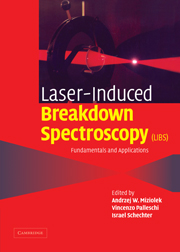Book contents
- Frontmatter
- Contents
- List of contributors
- Preface
- 1 History and fundamentals of LIBS
- 2 Plasma morphology
- 3 From sample to signal in laser-induced breakdown spectroscopy: a complex route to quantitative analysis
- 4 Laser-induced breakdown in gases: experiments and simulation
- 5 Analysis of aerosols by LIBS
- 6 Chemical imaging of surfaces using LIBS
- 7 Biomedical applications of LIBS
- 8 LIBS for the analysis of pharmaceutical materials
- 9 Cultural heritage applications of LIBS
- 10 Civilian and military environmental contamination studies using LIBS
- 11 Industrial applications of LIBS
- 12 Resonance-enhanced LIBS
- 13 Short-pulse LIBS: fundamentals and applications
- 14 High-speed, high-resolution LIBS using diode-pumped solid-state lasers
- 15 Laser-induced breakdown spectroscopy using sequential laser pulses
- 16 Micro LIBS technique
- 17 New spectral detectors for LIBS
- 18 Spark-induced breakdown spectroscopy: a description of an electrically generated LIBS-like process for elemental analysis of airborne particulates and solid samples
- Index
- References
18 - Spark-induced breakdown spectroscopy: a description of an electrically generated LIBS-like process for elemental analysis of airborne particulates and solid samples
Published online by Cambridge University Press: 08 August 2009
- Frontmatter
- Contents
- List of contributors
- Preface
- 1 History and fundamentals of LIBS
- 2 Plasma morphology
- 3 From sample to signal in laser-induced breakdown spectroscopy: a complex route to quantitative analysis
- 4 Laser-induced breakdown in gases: experiments and simulation
- 5 Analysis of aerosols by LIBS
- 6 Chemical imaging of surfaces using LIBS
- 7 Biomedical applications of LIBS
- 8 LIBS for the analysis of pharmaceutical materials
- 9 Cultural heritage applications of LIBS
- 10 Civilian and military environmental contamination studies using LIBS
- 11 Industrial applications of LIBS
- 12 Resonance-enhanced LIBS
- 13 Short-pulse LIBS: fundamentals and applications
- 14 High-speed, high-resolution LIBS using diode-pumped solid-state lasers
- 15 Laser-induced breakdown spectroscopy using sequential laser pulses
- 16 Micro LIBS technique
- 17 New spectral detectors for LIBS
- 18 Spark-induced breakdown spectroscopy: a description of an electrically generated LIBS-like process for elemental analysis of airborne particulates and solid samples
- Index
- References
Summary
Introduction
Spark-induced breakdown spectroscopy (SIBS) is a plasma-based atomic emission analytical technique that draws from both traditional spark spectroscopy and laser-induced breakdown spectroscopy (LIBS). Like traditional spark spectroscopy, the plasma is formed electrically. Like LIBS, the sparks are generally made in ambient air and detection is timed to eliminate the initial very bright breakdown. SIBS has been applied to a variety of interesting and challenging analytical problems. This chapter describes the basic hardware required to perform SIBS analyses. Here we also present the application of SIBS to real-time monitoring of airborne microparticulate lead in workplace hygiene scenarios, and the use of SIBS as a field-screening analyzer for metal contamination in soils.
SIBS can be regarded as a “marriage” of two other pulsed plasma techniques for elemental analysis: laser-induced breakdown spectroscopy and traditional spark spectroscopy. The latter is generally performed upon conductive samples (metals) and currently is predominantly used in alloy analysis. The sample itself acts as the cathode, and an anode is brought very near to the surface. An electrical discharge is formed between the electrode and the sample and ablates some material while simultaneously creating a plasma. The ablated material from the sample is vaporized, atomized, and electronically excited in the plasma. Elemental components of the sample are identified by the presence of their persistent emission lines. This detection is performed either immediately after the plasma is created or after a delay to enable plasma cooling, and spectral simplification, to take place.
- Type
- Chapter
- Information
- Laser Induced Breakdown Spectroscopy , pp. 585 - 614Publisher: Cambridge University PressPrint publication year: 2006
References
- 2
- Cited by

